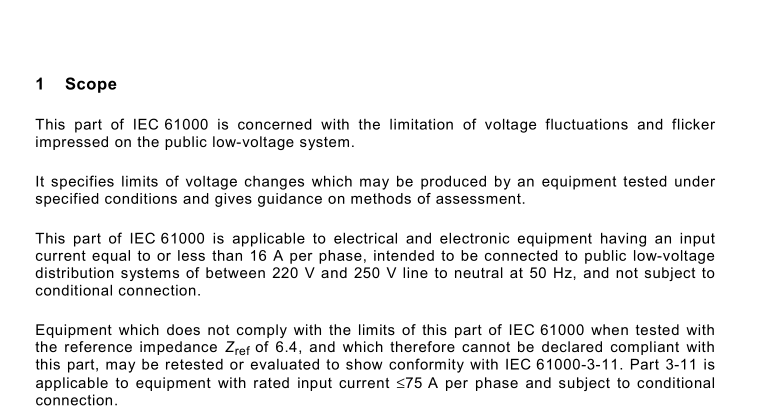IEC 61000-3-3:2008 pdf download – Electromagnetic compatibility (EMC) – Part 3-3: Limits – Limitation of voltage changes, voltage fluctuations and flicker in public low-voltage supply systems, for equipment with rated current ≤16 A per phase and not subject to conditional connection
4.2.3.2 Shape factor The shape factor, F, converts a relative voltage change characteristic d(t) into a flicker equivalent relative step voltage change (F · d max ).
NOTE 1 The shape factor, F, is equal to 1 ,0 for step voltage changes.
NOTE 2 The relative voltage change characteristic may be measured directly (see Figure 1 ) or calculated from the r.m.s. current of the equipment under test (see equations (1 ) to (4)). The relative voltage change characteristic shall be obtained from a histogram of U(t) (see Figure 3). The shape factor may be deduced from Figures 5, 6 and 7, provided that the relative voltage change characteristic matches a characteristic shown in the Figures. If the characteristics match, proceed as follows:
– find the maximum relative voltage change d max (according to Figure 3); and
– find the time T(ms) appropriate to the voltage change characteristic as shown in Figures 5, 6 and 7 and, using this value, obtain the required shape factor, F.
NOTE 3 Extrapolation outside the range of the Figures may lead to unacceptable errors.
4.2.4 Use of P st = 1 curve In the case of rectangular voltage changes of the same amplitude “d” separated by equal time intervals, the curve of Figure 4 may be used to deduce the amplitude corresponding to P st = 1 for a particular rate of repetition; this amplitude is called d lim . The P st value corresponding to the voltage change “d” is then given by P st = d/d lim .
4.3 Assessment of long-term flicker value, P lt The long-term flicker value P lt is defined in IEC 61 000-4-1 5 and shall be applied with the value of N = 1 2 (see 6.5). It is generally necessary to assess the value of P lt for equipment which is normally operated for more than 30 min at a time.
5 Limits
The limits shall be applicable to voltage fluctuations and flicker at the supply terminals of the equipment under test, measured or calculated according to Clause 4 under test conditions described in Clause 6 and Annex A. Tests made to prove compliance with the limits are considered to be type tests. The following limits apply:
– the value of P st shall not be greater than 1 ,0;
– the value of P lt shall not be greater than 0,65;
– the value of d(t) during a voltage change shall not exceed 3,3 % for more than 500 ms;
– the relative steady-state voltage change, d c , shall not exceed 3,3 %;
– the maximum relative voltage change d max , shall not exceed
a) 4 % without additional conditions; b) 6 % for equipment which is:
– switched manually, or
– switched automatically more frequently than twice per day, and also has either a delayed restart (the delay being not less than a few tens of seconds), or manual restart, after a power supply interruption.
NOTE The cycling frequency will be further limited by the P st and P lt limit. For example: a d max of 6 % producing a rectangular voltage change characteristic twice per hour will give a P lt of about 0,65. c) 7 % for equipment which is
– attended whilst in use (for example: hair dryers, vacuum cleaners, kitchen equipment such as mixers, garden equipment such as lawn mowers, portable tools such as electric drills), or
– switched on automatically, or is intended to be switched on manually, no more than twice per day, and also has either a delayed restart (the delay being not less than a few tens of seconds) or manual restart, after a power supply interruption.
In the case of equipment having several separately controlled circuits in accordance with 6.6, limits b) and c) shall apply only if there is delayed or manual restart after a power supply interruption; for all equipment with automatic switching which is energised immediately on restoration of supply after a power supply interruption, limits a) shall apply; for all equipment with manual switching, limits b) or c) shall apply depending on the rate of switching.
